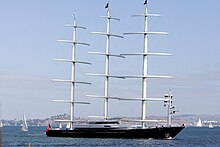Dynaship
Under the name Dynaship or Dyna-Rigg , the shipbuilding engineer Wilhelm Prölss originally developed a sailing system for cargo ships in Hamburg in the 1960s .
Dyna rig
It is characterized by the fact that modern square sails on rotating masts form a closed sail area (compared to historical square sails). The individual square sail surfaces are extended "from the center of the mast" - similar to a curtain - to the ends of the aerodynamically curved yards or rolled back into the mast when the wind increases . Each sail can be controlled individually and the ship can be adapted to any wind conditions.
The system offers a number of advantages: Wind is a free and clean energy carrier , in contrast to the energy carrier crude oil, with whose "waste product" heavy oil by diesel engine most cargo, ferry and cruise ships are currently powered. The previous conventional ship propulsion can, however, u. U. be designed much smaller. The auxiliary diesel for on-board energy supply could also be run with lower power if the on- board network is supported by the propeller-driven shaft generator as a tow generator, as is the case with sailing yachts, or even a battery bank is supplied with charging current.
Disadvantages are the high costs for the free-standing masts made of high- strength plastics reinforced with carbon fibers and the increased maintenance costs. For the originally intended use in freight traffic, it is also a disadvantage that - if wind is used exclusively as a drive - the arrival times cannot be planned precisely and the masts make it difficult or even impossible to move goods in the ports. However, due to the IMO's own goals of fossil-free shipping, the port industry - in coordination with shipping companies and the logistics industry - has to adapt to a change in cargo shipping with wind drives.
Ships with Dyna rig
The first ship with Dyna-Rigg was built in 2005 and 2006 on behalf of the private owner and internet billionaire Tom Perkins, the 88-meter yacht Maltese Falcon .
A group of students from Vienna also dealt with the topic of Dynaship and adapted the concept to a dinghy . The rig was developed as part of a school project at the Technological Trade Museum Vienna. The maiden voyage of the Victoria took place in September 2008 - as the second sailboat and the first dinghy worldwide with a Dyna rig.
A third ship, the 106 m yacht Black Pearl , was built by Oceanco in 2017 based on designs by Ken Freivokh and Dykstra Naval Architects.
Unrealized drafts
In the 1970s, a similar automated rig, the Pinta rig , was developed by Hartmut Schwarz in collaboration with Bremer Vulkan , which was planned again in 2006.
The WASP (Wind Assisted Ship) "Ecoliner" is a design by the Dutch shipbuilding office Dykstra, which is looking for investors (2016). It is said to have a displacement of 11,850 t and to serve freight traffic.
literature
- Helmut Risch, Jochen Bertholdt: Windships . 2nd edition, Verlag Technik, Berlin 1990
- K.-H. High-rise: STG consultation day “Innovative Ships” in Kiel . In: Hansa Heft 4/2010, pp. 44-47 , Schiffahrts-Verlag Hansa, Hamburg 2010, ISSN 0017-7504
Web links
Individual evidence
- ↑ International Maritime Organization: UN body adopts climate change strategy for shipping. Retrieved April 20, 2020 .
- ↑ Video of the maiden voyage
- ↑ from yachtharbour.com
- ↑ Video
- ↑ PDF prospectus at www.windschiffe.de
- ↑ http://www.dykstra-na.nl/designs/wasp-ecoliner/

